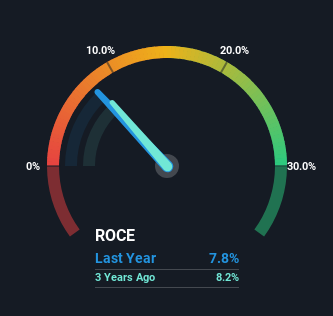Returns On Capital Signal Tricky Times Ahead For DFI Retail Group Holdings (SGX:D01)
To find a multi-bagger stock, what are the underlying trends we should look for in a business? Firstly, we'll want to see a proven return on capital employed (ROCE) that is increasing, and secondly, an expanding base of capital employed. If you see this, it typically means it's a company with a great business model and plenty of profitable reinvestment opportunities. However, after investigating DFI Retail Group Holdings (SGX:D01), we don't think it's current trends fit the mold of a multi-bagger.
Understanding Return On Capital Employed (ROCE)
For those who don't know, ROCE is a measure of a company's yearly pre-tax profit (its return), relative to the capital employed in the business. To calculate this metric for DFI Retail Group Holdings, this is the formula:
Return on Capital Employed = Earnings Before Interest and Tax (EBIT) ÷ (Total Assets - Current Liabilities)
0.078 = US$275m ÷ (US$6.9b - US$3.4b) (Based on the trailing twelve months to June 2023).
So, DFI Retail Group Holdings has an ROCE of 7.8%. In absolute terms, that's a low return but it's around the Consumer Retailing industry average of 8.9%.
Check out our latest analysis for DFI Retail Group Holdings
Above you can see how the current ROCE for DFI Retail Group Holdings compares to its prior returns on capital, but there's only so much you can tell from the past. If you're interested, you can view the analysts predictions in our free report on analyst forecasts for the company.
So How Is DFI Retail Group Holdings' ROCE Trending?
When we looked at the ROCE trend at DFI Retail Group Holdings, we didn't gain much confidence. Around five years ago the returns on capital were 20%, but since then they've fallen to 7.8%. However it looks like DFI Retail Group Holdings might be reinvesting for long term growth because while capital employed has increased, the company's sales haven't changed much in the last 12 months. It's worth keeping an eye on the company's earnings from here on to see if these investments do end up contributing to the bottom line.
On a related note, DFI Retail Group Holdings has decreased its current liabilities to 49% of total assets. That could partly explain why the ROCE has dropped. Effectively this means their suppliers or short-term creditors are funding less of the business, which reduces some elements of risk. Since the business is basically funding more of its operations with it's own money, you could argue this has made the business less efficient at generating ROCE. Keep in mind 49% is still pretty high, so those risks are still somewhat prevalent.
Our Take On DFI Retail Group Holdings' ROCE
Bringing it all together, while we're somewhat encouraged by DFI Retail Group Holdings' reinvestment in its own business, we're aware that returns are shrinking. It seems that investors have little hope of these trends getting any better and that may have partly contributed to the stock collapsing 70% in the last five years. All in all, the inherent trends aren't typical of multi-baggers, so if that's what you're after, we think you might have more luck elsewhere.
If you'd like to know about the risks facing DFI Retail Group Holdings, we've discovered 1 warning sign that you should be aware of.
While DFI Retail Group Holdings may not currently earn the highest returns, we've compiled a list of companies that currently earn more than 25% return on equity. Check out this free list here.
Have feedback on this article? Concerned about the content? Get in touch with us directly. Alternatively, email editorial-team (at) simplywallst.com.
This article by Simply Wall St is general in nature. We provide commentary based on historical data and analyst forecasts only using an unbiased methodology and our articles are not intended to be financial advice. It does not constitute a recommendation to buy or sell any stock, and does not take account of your objectives, or your financial situation. We aim to bring you long-term focused analysis driven by fundamental data. Note that our analysis may not factor in the latest price-sensitive company announcements or qualitative material. Simply Wall St has no position in any stocks mentioned.

